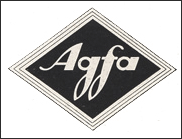


AGFA-ANSCO
Poor Ansco has arguably the most tortured history of any of the major marquees.
In the late 1800s photography was an expensive art. Like cabinetmaking or metal-smithing, photography required a substantial investment in materials and expertise. There were no light meters. Materials were not very standardized. Photographers developed their skills from practice, intuition and luck.
The E & H.T. Anthony Company was an outfitter: they sold photographic supplies to professionals. When Eastman Kodak began, it sold photographic plates through Anthony and everyone was happy (for the time being).
But Eastman wanted to grow. In time it broadened its product line, began making cameras, and started selling its equipment through its own chain of stores; this last business arm put it directly in competition with Anthony. And no matter what anyone may say about competition being good, businessmen hate competition. Especially when they lose market share.
Eastman fundamentally changed the business of photography by opening it up to the mass market. It also made and sold professional caliber equipment to professionals. Anthony, along with a lot of other businesses, found itself squeezed hard by the emerging giant.
Many companies folded, many others were acquired by Eastman Kodak. The rest limped along. Anthony and some other independents held out as long as they could; then finally decided that the best thing to do was to sell out to Kodak, but they would make them pay dearly for it. Anthony, a camera maker named Scoville, and several others merged together to form a company called the Anthony & Scoville Company, which was quickly shortened to Ansco. Together, they figured, they would get more money from Kodak than they would apart.
Every so often large companies reach major crossroads that fundamentally change their landscapes. General Motors had the opportunity to acquire Ford Motors but the Board of Directors killed the deal; the next year Henry Ford introduced the Model A. For Eastman Kodak, this was their chance to buy, and finish off, their primary domestic competitor and they didn't do it. George Eastman bet that Ansco would fail on its own.
It almost did; but Ansco had an important, fundamental patent and they claimed Eastman Kodak infringed on it. Ansco sued. Kodak fought it tooth and nail for years but eventually lost. The judgement kept Ansco viable and in business.
But even then it was never enough. In 1928 it was bought by a German film and camera giant called Agfa, and the American subsidiary became Agfa-Ansco. Agfa had begun in 1867 as a chemical company dealing in analine, and its name was the acronym "Actien Gesellschaft für Anilin Fabrikation." Like Eastman Kodak it began primarily making films and materials, but eventually became a camera maker as well.
Agfa-Ansco competed directly against Kodak in its bread-and-butter niche, the low-end mass-market. Unlike Kodak, Agfa-Ansco didn't have much vertical reach. Kodak made cameras and equipment for every tier of photography, from simple Brownie point-n-shoots to commercial-professional grade. Agfa-Ansco only made a few "better" cameras, and its corporate image was that of a Ford or Chevy: cheap and reliable, but that's it.
Agfa-Ansco continued along until the early 40s, when suddenly that German name wasn't such a good idea on an American company, and they reverted back to Ansco (but they were still owned by Agfa). After World War II, Ansco went along about the same as before: always number 2 to Kodak. Agfa suffered from the division of Germany and a further break-up due to its involvement with the former Nazi government, but overcame both problems and continued to be a major film and camera maker in Europe.
Ansco limped along as usual, but it never grew well in the deep shadow of Kodak. Newcomer Polaroid ate heavily into the point-n-shoot market, Japanese cameras became cheaper and increasingly admired. Kodak was healthy and could survive it, but everyone else suffered. In the 60s it changed its name again, this time to General Analine & Film, aka GAF, where it would continue on for another 20 years until it finally bailed out of the consumer market altogether.